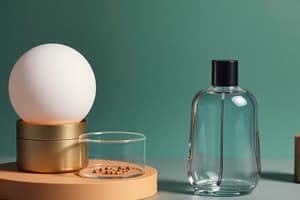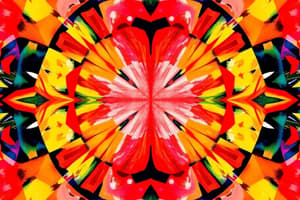Podcast
Questions and Answers
What is a primary function of a machine that uses computer-generated 3D modeling?
What is a primary function of a machine that uses computer-generated 3D modeling?
- Developing software applications
- Creating 2D drawings
- Performing data analysis
- Prototyping physical objects (correct)
Which of the following materials can be used in 3D prototyping?
Which of the following materials can be used in 3D prototyping?
- Glass
- ABS plastic (correct)
- Wood
- Paper (correct)
What characteristic is NOT associated with materials used in 3D prototyping processes?
What characteristic is NOT associated with materials used in 3D prototyping processes?
- They may resemble food items.
- They require high heat to produce.
- They can be biodegradable.
- They are mostly metals. (correct)
Which material is specifically mentioned as being similar to a food product in the context of 3D prototyping?
Which material is specifically mentioned as being similar to a food product in the context of 3D prototyping?
What is one benefit of using rapid prototyping techniques?
What is one benefit of using rapid prototyping techniques?
What is one advantage of using rapid prototype models over traditional manual models?
What is one advantage of using rapid prototype models over traditional manual models?
How accurate are rapid prototype models when measured?
How accurate are rapid prototype models when measured?
What is rapid prototyping primarily used for?
What is rapid prototyping primarily used for?
What is a potential drawback of traditional manual modeling compared to rapid prototyping?
What is a potential drawback of traditional manual modeling compared to rapid prototyping?
Which method does rapid prototyping utilize to build models?
Which method does rapid prototyping utilize to build models?
Which statement is true about the production speed of rapid prototype models?
Which statement is true about the production speed of rapid prototype models?
What is one of the key features of rapid prototyping?
What is one of the key features of rapid prototyping?
Why might a company choose rapid prototyping over traditional methods?
Why might a company choose rapid prototyping over traditional methods?
What is one of the main responsibilities of someone involved in product development?
What is one of the main responsibilities of someone involved in product development?
In rapid prototyping, what does the term 'layering' refer to?
In rapid prototyping, what does the term 'layering' refer to?
Which of the following best describes the speed of the rapid prototyping process?
Which of the following best describes the speed of the rapid prototyping process?
Which activity is essential for promoting products before their launch?
Which activity is essential for promoting products before their launch?
In addition to sourcing materials, which other task is key in the product development process?
In addition to sourcing materials, which other task is key in the product development process?
What is the main difference between rapid prototyping and CNC machining?
What is the main difference between rapid prototyping and CNC machining?
Which statement accurately describes rapid prototyping?
Which statement accurately describes rapid prototyping?
What role does developing proposals play in the product lifecycle?
What role does developing proposals play in the product lifecycle?
In the context of manufacturing processes, what does 'additive process' refer to?
In the context of manufacturing processes, what does 'additive process' refer to?
Which of the following best describes the role of selling products after their launch?
Which of the following best describes the role of selling products after their launch?
Which of the following is a characteristic of CNC machining?
Which of the following is a characteristic of CNC machining?
What is a common application of rapid prototyping?
What is a common application of rapid prototyping?
What do Intellectual Property Rights primarily concern?
What do Intellectual Property Rights primarily concern?
Which of the following is specifically covered under confidentiality?
Which of the following is specifically covered under confidentiality?
Which of the following industries is most likely to need strong confidentiality protections?
Which of the following industries is most likely to need strong confidentiality protections?
What type of information could be considered a trade secret?
What type of information could be considered a trade secret?
In the context of intellectual property, what would 'confidentiality' primarily assure?
In the context of intellectual property, what would 'confidentiality' primarily assure?
Flashcards
Intellectual Property Rights (IPR)
Intellectual Property Rights (IPR)
Rules about who owns creative work, inventions, and designs.
Ownership of knowledge
Ownership of knowledge
Intellectual property rights determine who has the legal right to use and profit from knowledge, ideas, technology, and designs.
Confidentiality
Confidentiality
Keeping information secret to protect ownership.
Recipes and formulas
Recipes and formulas
Signup and view all the flashcards
Protecting formulas
Protecting formulas
Signup and view all the flashcards
3D model
3D model
Signup and view all the flashcards
Rapid Prototyping
Rapid Prototyping
Signup and view all the flashcards
Material Examples
Material Examples
Signup and view all the flashcards
Computer-generated 3D
Computer-generated 3D
Signup and view all the flashcards
Physical Model
Physical Model
Signup and view all the flashcards
Layered Building
Layered Building
Signup and view all the flashcards
Computer-Controlled Machinery
Computer-Controlled Machinery
Signup and view all the flashcards
Accurate Solid Models
Accurate Solid Models
Signup and view all the flashcards
Benefits of Rapid Prototyping
Benefits of Rapid Prototyping
Signup and view all the flashcards
Additive Process
Additive Process
Signup and view all the flashcards
CNC Machining
CNC Machining
Signup and view all the flashcards
Reductive Process
Reductive Process
Signup and view all the flashcards
Rapid Prototyping vs. CNC Machining
Rapid Prototyping vs. CNC Machining
Signup and view all the flashcards
Rapid Prototype Accuracy
Rapid Prototype Accuracy
Signup and view all the flashcards
Rapid Prototyping Speed
Rapid Prototyping Speed
Signup and view all the flashcards
Why is Rapid Prototyping Advantageous?
Why is Rapid Prototyping Advantageous?
Signup and view all the flashcards
Product Development
Product Development
Signup and view all the flashcards
Sourcing & Buying
Sourcing & Buying
Signup and view all the flashcards
Research
Research
Signup and view all the flashcards
Advertising & Selling
Advertising & Selling
Signup and view all the flashcards
Product Launch
Product Launch
Signup and view all the flashcards
Study Notes
Aesthetics in Product Design
- Aesthetics is concerned with how something looks and appeals to the human eye.
- In product design, aesthetics are highly valued, as the human eye is often initially attracted to something based on its appearance.
- People are frequently drawn to a product's look before considering other important factors like function.
Important Aesthetic Factors in Product Design
- Does the product appeal to its target market?
- Does it blend in with its surroundings?
- Does the product look sturdy, durable, and robust?
- Does it look clean and easy to maintain?
- Does the product appear expensive?
- Does the product seem superior to similar existing products?
Symmetry/Asymmetry
- Studies indicate that humans generally prefer symmetrical objects over asymmetrical ones.
Idea Generation Techniques
- Designers use various techniques to generate many ideas quickly.
- Brainstorming/Thought Showers: A group activity where people from diverse backgrounds or areas of expertise discuss possibilities for new ideas.
- Technology Transfer: Adapting solutions to problems from other fields of technology or nature.
Lateral Thinking
- Lateral thinking, often described as "thinking outside the box," approaches problem-solving by avoiding obvious or direct solutions.
- It encourages exploring innovative and seemingly impossible ways to solve a problem, leading to more creative and original solutions.
Analogy
- Analogies help generate ideas by comparing a product or problem to a similar concept or object.
- Using simple comparisons can provide fresh perspectives on products and suggest new possibilities.
Intellectual Property Rights (IPR)
- Confidentiality: Covers trade secrets like recipes, formulas, and similar information. Examples include fireworks or chemicals and medicines information.
- Copyright: Protects creative works such as music, novels, films, and paintings.
- Patent: Secure proprietary rights for a new technology, gadget, or mechanism. An application goes to the patent office.
- Trademark: Patents new technology, gadgets, and mechanisms.
- Brand: Brand reputation affects customers perceptions of quality, reliability, and value.
- Design Rights: Protect unique designs of an existing product, even if it has a new look or function. Design patents can protect the design, but not the invention.
- Registered Design: Protects the appearance or a product, like a unique toaster appearance.
Modelling Techniques in Product Design
- Designers use modeling techniques to generate ideas, develop designs, and communicate details to team members and the public.
- Models are made from various materials and used at different stages of the design process.
Graphic Tech - Mock-Ups
- Quick models used to visualize the aesthetic appeal and size/ergonomics of an idea, using paper and easy-to-manipulate materials.
Test Model/Test Rig
- Working models of product parts or sections, to check mechanisms, electronics, and other crucial aspects.
- Ensuring proper function before production.
Scale Model
- Smaller or larger-scale models of a product (e.g., a ship or a building).
- Allows for evaluating appearance and feedback from potential customers, without building a full-scale product.
Block Model
- Life-size models that look like the final product.
- Evaluates aesthetics and basic ergonomics without worrying about manufacturing the product.
Prototype
- A full-scale working model of a product, assessing function and mechanical/electronic components.
- Often expensive, but crucial to ensure a final product functions and is reliable.
Computer Models (3D Models)
- Computer-generated models to detail product designs.
- Tools to simulate operation and check for safety issues.
Rapid Prototyping
- A rapid process for producing accurate models of computer designs.
- Builds models in layers, using computer control of machinery.
Rapid Prototyping - The Process
- Designers generate a 3-dimensional product model.
- Computer software converts the model to a detailed layer-by-layer file.
- Rapid prototyping machinery builds the product by combining/adding layers of material.
- Additional material (water-soluble) can be used for overhanging sections until the work is complete, which can be removed without affecting the product.
Rapid Prototyping Advantages
- Models produced quickly, compared to traditional methods.
- Precise models with accuracy to the 1000th of a millimeter.
- Checking components fit together efficiently, eliminating costly errors.
- Ergonomic evaluation possible before manufacturing.
- Reduces time to develop and market products.
- Enables quick design modifications.
Rapid Prototyping Disadvantages
- Rapid prototyping equipment is expensive.
- Material limitations mean only one material can be used at a time.
- Size limitations from the machine; products are only made as big as the machine can accommodate.
- Over-designing and wasting time can occur.
The Design Team
- Product development teams consist of professionals with varying skills.
- Common roles within the team include designers, production managers, and marketers.
Design Team Roles
- Designer: Creates and develops the product, ensuring function and suitability to the target market.
- Engineer: Checks and guarantees the reliability of components, and chooses the correct materials for the product.
- Manufacturer: Responsible for product assembly, adhering to designs and specifications.
- Market Researcher: Researches the target market and customer needs, and creates appropriate marketing information.
- Accountant: Manages the financial aspects of the project, ensuring profitability, by examining the costs of the project against potential earnings.
- Lawyer: Handles legal issues related to the product, patents, and safety.
Studying That Suits You
Use AI to generate personalized quizzes and flashcards to suit your learning preferences.




